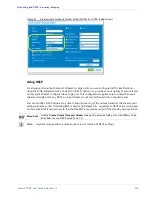
Selenio
TM
BNP User Guide, Release 3.7.1
114
- Grooming - Mapping
Figure 65.
Create Output Transport Stream (ASI)—MPEG-2 or SCTE
1.
At the
Create Output Transport Stream
dialog
TS Type
field, select,
MPEG-2
.
2.
Use guidelines from
to provide MPEG-2 information in the remaining fields.
3.
Click
OK
to save your settings and to place the new transport stream in the
Outputs
panel of the
Grooming
->
Mapping
tab screen beneath the selected ASI port.
Table 63.
Create Output Transport Stream Dialog Parameters (ASI)—MPEG-2 or SCTE
Field
Description
Port
Read-only, shows either ASI or GigE depending on the port selected.
SPTS
Check if the output is a single program transport stream (SPTS).
Non-DPI
Check this box if the transport stream is to use a Grooming-only (Non-DPI)
license.
TS Name
The (optional) name you want to assign to this output transport stream.
Bitrate (Mbps)
The bitrate at which the stream is transported.
Unique TS ID
Allows you to assign a unique numeric ID to this transport stream.
• When this option is
checked
, the TS ID value placed in this field will be
reserved as unique for the entire chassis.
• When this option is
unchecked
, a TS ID value may still be entered,
however the value may be the same as another TS ID as long as that TS
ID’s value has not been reserved as a Unique TS ID.
• Note that each TSID is a unique number used to identify a transport
stream. It is a partition of two 16-bit hex numbers. The lower 16 bits (user-
specified in decimal and converted to hex) is the MPEG transport stream
ID. The upper 16 bits (0x) is strictly used internally.
• Default value is “
1
” if no value is specified.
• Broadcasters must configure this value with a unique ID to meet FCC
standards.
Reserved Bandwidth
Enter any bandwidth value to be reserved from the total bitrate of transport
stream.
Network PID
Decimal value to define the program ID on which network information is
received.
Note that display of this entry, in applicable screens, is dependent on the
current setting—as either hexadecimal or decimal—for
Configuration
--
>
Global PID Display.






























